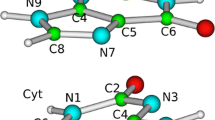Abstract
The nonradiative decay of a π-stacked pair of adenine molecules, one of which was excited by an ultrafast laser pulse, is studied by semiclassical dynamics simulations. This simulation investigation is focused on the effect of the formation of bonded excimer in stacked adenines on the mechanism of ultrafast decay. The simulation finds that the formation of the bonded excimer significantly lowers the energy gap between the LUMO and HOMO and consequently facilitates the deactivation of the electronically excited molecule. On the other hand, the formation of the chemical bond between two stacked adenines restricts the deformation vibration of the pyrimidine of the excited molecule due to the steric effect. This slows down the formation of the coupling between the HOMO and LUMO energy levels and therefore delays the deactivation process of the excited adenine molecule to the electronic ground state.
Similar content being viewed by others
References
Beukers R, Eker APM, Lohman PHM. 50 Years thymine dimer. DNA Repair, 2008, 7: 530–543
Middleton CT, de La Harpe K, Su C, Law YK, Crespo-Hernandez CE, Kohler B. DNA excited-state dynamics: From single bases to the double helix. Annu Rev Phys Chem, 2009, 60: 217–239
Davies RJH, Malone JF, Gan Y, Cardin CJ, Lee MPH, Neidle S. High-resolution crystal structure of the intramolecular d(TpA) thymine-adenine photoadduct and its mechanistic implications. Nucleic Acids Res, 2007, 35: 1048–1053
Shukla MK, Leszczynski J. Electronic spectra, excited state structures and interactions of nucleic acid bases and base assemblies: A review. J Biomol Struct Dyn, 2007, 25: 93–118
Ullrich S, Schultz T, Zgierski MZ, Stolow A. Direct observation of electronic relaxation dynamics in adenine via time-resolved photoelectron spectroscopy. J Am Chem Soc, 2004, 126: 2262–2263
Schwalb NK, Temps F. Base sequence and higher-order structure induce the complex excited-state dynamics in DNA. Science, 2008, 322: 243–245
Buchvarov I, Wang Q, Raytchev M, Trifonov A, Fiebig T. Electronic energy delocalization and dissipation in single- and double-stranded DNA. Proc Natl Acad Sci USA, 2007, 104: 4794–4797
Tonzani S, Schatz GC. Electronic excitations and spectra in single-stranded DNA. J Am Chem Soc, 2008, 130: 7607–7612
Crespo-Hernandez CE, Kohler B. Influence of secondary structure on electronic energy relaxation in adenine homopolymers. J Phys Chem B, 2004, 108: 11182–11188
Kwok WM, Ma CS, Phillips DL. Femtosecond time- and wavelength-resolved fluorescence and absorption spectroscopic study of the excited states of adenosine and an adenine oligomer. J Am Chem Soc, 2006, 128: 11894–11905
Santoro F, Barone V, Improta R. Influence of base stacking on excited-state behavior of polyadenine in water, based on time-dependent density functional calculations. Proc Natl Acad Sci USA, 2007, 104: 9931–9936
Crespo-Hernandez CE, Cohen B, Kohler B. Base stacking controls excited-state dynamics in A-T DNA. Nature, 2005, 436: 1141–1144
Plessow R, Brockhinke A, Eimer W, Kohse-Hoinghaus K. Intrinsic time- and wavelength-resolved fluorescence of oligonucleotides: A systematic investigation using a novel picosecond laser approach. J Phys Chem B, 2000, 104: 3695–3704
Wang YS, Haze O, Dinnocenzo JP, Farid S, Farid RS, Gould IR. Bonded exciplexes. A new concept in photochemical reactions. J Org Chem, 2007, 72: 6970–6981
Wang YS, Haze O, Dinnocenzo JP, Farid S, Farid RS, Gould IR. Bonded exciplex formation: Electronic and stereoelectronic effects. J Phys Chem A, 2008, 112: 13088–13094
Yuan SA, Zhang WY, Li AY, Zhu YM, Dou YS. Dynamics simulation of a new deactivation pathway for stacked adenines. Acta Physico-Chimica Sinica, 2011, 27: 825–830
Dou YS, Torralva BR, Allen RE. Semiclassical electron-radiation-ion dynamics (SERID) and cis-trans photoisomerization of butadiene. J Mod Opt, 2003, 50: 2615–2643
Dou YS, Torralva BR, Allen RE. Interplay of electronic and nuclear degrees of freedom in a femtosecond-scale photochemical reaction. Chem Phys Lett, 2004, 392: 352–357
Boykin TB, Bowen RC, Klimeck G. Electromagnetic coupling and gauge invariance in the empirical tight-binding method. Phys Rev B, 2001, 63
Porezag D, Frauenheim T, Kohler T, Seifert G, Kaschner R. Construction of tight binding -like potentials on the basis of density-functional theory — Application to carbon. Phys Rev B, 1995, 51: 1294–12957
Elstner M, Porezag D, Jungnickel G, Elsner J, Haugk M, Frauenheim T, Suhai S, Seifert G. Self-consistent-charge density-functional tight-binding method for simulations of complex materials properties. Phys Rev B, 1998, 58: 7260–7268
Lei YB, Yuan SA, Dou YS, Wang YB, Wen ZY. Detailed dynamics of the nonradiative deactivation of adenine: A semiclassical dynamics study. J Phys Chem A, 2008, 112: 8497–8504
Dou YS, Xiong SS, Wu WF, Yuan SA, Tang H. Photoinduced dissociation of cyclobutane thymine dimer studied by semiclassical dynamics simulation. J Photoch Photobio B, 2010, 101: 31–36
Zhang WY, Yuan SA, Li AY, Dou YS, Zhao JS, Fang WH. Photoinduced thymine dimerization studied by semiclassical dynamics simulation. J Phys Chem C, 2010, 114: 5594–5601
Allen RE, Dumitrica T, Torralva BR. Electronic and structrual pesponse of materials to fast, intence laser pluse. In: Tsen KT, ed. Ultrafast Physical Processes in Semiconductors. New York: Academic Press, 2001.315–384
Domcke W, Yarkony DR, Köppel H. Conical Intersections: Electronic Structure, Dynamics & Spectroscopy. Singapore: World Scientific, 2004.3–41
Baer M. Beyond Born-Oppenheimer: Electronic Nonadiabatic Coupling Terms and Conical Intersections, Hoboken: Wiley Interscience, 2006
Bearpark MJ, Bernardi F, Clifford S, Olivucci M, Robb MA, Vreven T. Cooperating rings in cis-stilbene lead to an S 0/S 1 conical intersection. J Phys Chem A, 1997, 101: 3841–3847
Levine BG, Martinez TJ. Isomerization through conical intersections. Annu Rev Phys Chem, 2007, 58: 613–634
Zhang WY, Yuan SA, Wang ZJ, Qi ZM, Zhao JS, Dou YS, Lo GV. A semiclassical dynamics simulation for a long-lived excimer state of π-stacked adenines. Chem Phys Lett, 2011, 506: 303–308
Conti I, Altoe P, Stenta M, Garavelli M, Orlandi G. Adenine deactivation in DNA resolved at the CASPT2//CASSCF/AMBER level. Phys Chem Chem Phys, 2010, 12: 5016–5023
Author information
Authors and Affiliations
Corresponding author
Rights and permissions
About this article
Cite this article
Dou, Y., Zhao, W., Yuan, S. et al. Bonded excimer in stacked adenines: Semiclassical simulations. Sci. China Chem. 55, 1377–1383 (2012). https://doi.org/10.1007/s11426-012-4578-x
Received:
Accepted:
Published:
Issue Date:
DOI: https://doi.org/10.1007/s11426-012-4578-x




